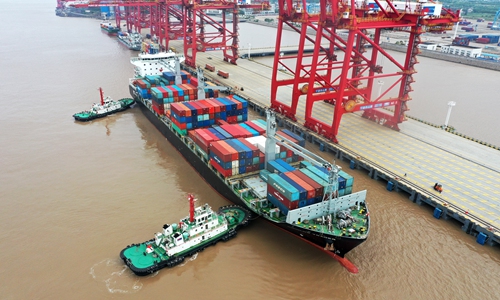
A cargo ship docks at the international container terminal in Zhoushan Port, East China's Zhejiang Province. Photo: cnsphoto
Due to the impact of the COVID-19 pandemic, Argentina is on the brink of another debt default, posing a certain risk to some Chinese infrastructure projects in the Latin American nation.
It should be noted that at the end of last year, Argentina expressed strong interest in joining the Belt and Road Initiative (BRI). It is worrying to see the economic predicament faced by Argentina and assistance at the national level could be offered, but BRI-related projects should always be carried out based on business models. And the principle applies to all Latin American countries with an interest in the BRI.
In recent days, China has been under pressure to grant debt relief to countries under the BRI that are struggling to repay relevant project loans due to the impact of the coronavirus pandemic, according to Western media reports. Yet, simply writing off loans will only strangle the long-term development of the BRI. If COVID-19 causes any problems in the debt servicing of BRI-related projects, they should be addressed through business models.
Last month, the Group of 20 agreed to provide temporary debt relief for the world's poorest nations as they struggle to combat the COVID-19 crisis. The move is, of course, welcome and essential, but we cannot confuse such debt relief at the national level with the debt issues of some BRI projects. Commercialization is crucial to the attractiveness of the BRI to private investment, which guarantees the projects' long-term sustainability. The pandemic poses a challenge and test for BRI projects. Yet, from another angle, the BRI scheme is a long-term collaborative plan, so it is common for problems to emerge from projects. In fact, market capital has long shunned infrastructure projects, which are characterized by high risk and long investment cycles. How to explore an innovative approach to promoting the commercialized development of BRI projects will therefore be key to strengthening investor confidence and attracting more commercial investment in such projects.
If the debt issue can be resolved through a business approach during the coronavirus crisis, that would also be a good opportunity to show that the BRI is a truly open, collaborative and transparent platform that will be conducive to attracting private investment in the future.
And if BRI projects gain traction from private investment, countries along the route would also benefit. In the aftermath of the pandemic, countries will have to focus on how to recover from the economic repercussions. If private investment could be attracted to their infrastructure projects, that would be a huge boost to the recovery process and would also be in line with the common interests of all.




